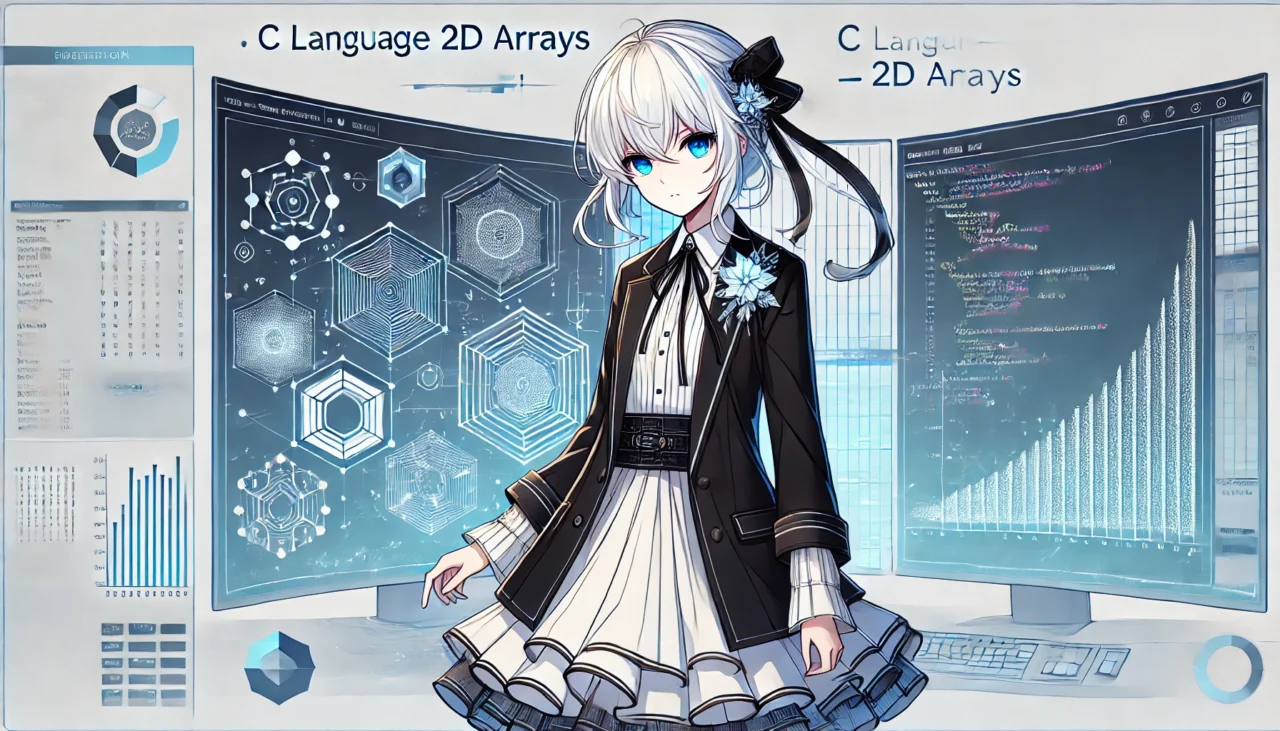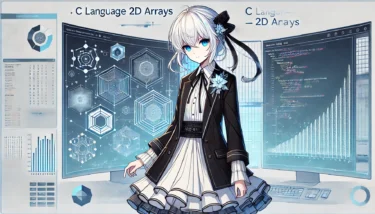目次
- 1 1. Introduction
- 2 2. What Is a Two-Dimensional Array?
- 3 3. Declaring and Initializing Two-Dimensional Arrays
- 3.1 How to Declare a Two-Dimensional Array
- 3.2 Initializing Two-Dimensional Arrays
- 3.3 Code Example: Declaring and Initializing Arrays
- 3.4 Output
- 3.5 4. Using Two-Dimensional Arrays: Accessing and Modifying Elements
- 3.6 Accessing Elements
- 3.7 Modifying Elements
- 3.8 Looping Through Two-Dimensional Arrays
- 3.9 Practical Example: Setting All Elements to a Specific Value
- 4 5. Understanding the Memory Layout of Two-Dimensional Arrays
- 5 6. Practical Examples: Matrix Operations and Game Boards
- 6 7. Relationship Between Two-Dimensional Arrays and Pointers
- 6.1 Basic Relationship Between Two-Dimensional Arrays and Pointers
- 6.2 Referencing Elements with Pointers
- 6.3 Passing Two-Dimensional Arrays to Functions
- 6.4 Dynamic Two-Dimensional Arrays with Pointers
- 6.5 8. How to Dynamically Allocate and Free Two-Dimensional Arrays
- 6.6 Basics of Dynamic Memory Allocation
- 6.7 Two Methods of Creating Dynamic Two-Dimensional Arrays
- 6.8 Precautions When Using Dynamic Memory
- 7 9. Precautions When Using Two-Dimensional Arrays
- 8 10. Summary
1. Introduction
The C programming language is one of the most important and historically significant programming languages. Among its many features, arrays are a fundamental tool for managing and manipulating data efficiently. In particular, two-dimensional arrays are extremely useful when working with matrices or table-like data structures. This article provides a beginner-friendly explanation of two-dimensional arrays in C. We will walk step by step from the basics to practical use cases, giving you useful insights you can apply when writing your own programs.The Importance of Arrays in C
In C, an array is a data structure that allows you to manage multiple elements of the same type as a single unit. This eliminates the need to declare individual variables, helping you keep your code concise. For example, when you need to store multiple numbers or strings, arrays let you handle them more efficiently. Two-dimensional arrays are especially helpful in situations such as:- Performing mathematical matrix calculations
- Managing game boards (e.g., chess or Othello)
- Handling tabular data structures like spreadsheets
What You Will Learn in This Article
By reading this article, you will learn the following step by step:- The basic structure of two-dimensional arrays and how to declare them
- How to initialize arrays and access elements
- How two-dimensional arrays are stored in memory
- Practical examples of using arrays in real programs
- How to dynamically allocate and free two-dimensional arrays
- Common pitfalls and errors when working with arrays
Who This Article Is For
This guide is intended for learners ranging from beginners just starting with C to intermediate programmers looking to expand their skills. It will be particularly useful if you:- Understand the basics of arrays but have never used two-dimensional arrays
- Want to handle table-like data in your programs
- Wish to review the fundamentals of C programming
2. What Is a Two-Dimensional Array?
In C, a two-dimensional array is a data structure that stores elements in rows and columns. Essentially, it works as an “array of arrays.” This makes it ideal for matrix calculations and tabular data handling, and it is widely used in practical programming. Here, we will explain the basic concept and structure of two-dimensional arrays in detail.Basic Structure of Two-Dimensional Arrays
A two-dimensional array consists of multiple rows and columns. Specifically, each row is a one-dimensional array, and all rows together form the two-dimensional array.Example: Visualizing a Two-Dimensional Array
Data is stored using rows and columns, as shown below:array[3][4] = {
{1, 2, 3, 4},
{5, 6, 7, 8},
{9, 10, 11, 12}
};array is a 3×4 two-dimensional array. You can access specific elements using indexes.array[0][0]→ 1array[2][3]→ 12
Use Cases of Two-Dimensional Arrays
Two-dimensional arrays are commonly used in the following scenarios:- Mathematical matrix operations Example: addition and multiplication of matrices
- Tabular data management Example: spreadsheet-like or database-style structures
- Game development Example: representing the state of a chessboard or Othello board
- Image processing Example: storing pixel color values
Difference Between One-Dimensional and Two-Dimensional Arrays
Characteristics of One-Dimensional Arrays
A one-dimensional array stores data in a simple, linear fashion:int array[5] = {1, 2, 3, 4, 5};array[0]→ 1array[4]→ 5
Characteristics of Two-Dimensional Arrays
A two-dimensional array stores data across both rows and columns:int array[2][3] = {
{1, 2, 3},
{4, 5, 6}
};array[0][2]→ 3array[1][0]→ 4
3. Declaring and Initializing Two-Dimensional Arrays
To use a two-dimensional array in C, you first need to declare it, and optionally initialize it. Let’s go through the declaration and various initialization methods step by step.How to Declare a Two-Dimensional Array
The declaration follows this format:data_type array_name[rows][columns];- data_type: The type of data to be stored (e.g.,
int,float,char). - rows and columns: Integer values defining the size of the array.
Example Declaration
A 3×4 integer array can be declared as follows:int array[3][4];Initializing Two-Dimensional Arrays
You can initialize a two-dimensional array at the time of declaration. There are several methods:Method 1: Explicitly Initialize All Elements
int array[2][3] = {
{1, 2, 3},
{4, 5, 6}
};1 2 3
4 5 6array[0][0]→ 1array[1][2]→ 6
Method 2: Partially Initialize Elements
int array[2][3] = {
{1, 2},
{4}
};1 2 0
4 0 0Method 3: Zero Initialization with {0}
int array[3][4] = {0};Important Notes on Initialization
- Row count cannot be omitted The first dimension (number of rows) must always be specified.
int array[][4] = {
{1, 2, 3, 4},
{5, 6, 7, 8}
};- Column count is required You must always specify the number of columns (the second dimension).
Code Example: Declaring and Initializing Arrays
The following code declares a two-dimensional array, initializes it, and then prints each element:#include <stdio.h>
int main() {
int array[2][3] = {
{1, 2, 3},
{4, 5, 6}
};
for (int i = 0; i < 2; i++) {
for (int j = 0; j < 3; j++) {
printf("array[%d][%d] = %d\n", i, j, array[i][j]);
}
}
return 0;
}Output
array[0][0] = 1
array[0][1] = 2
array[0][2] = 3
array[1][0] = 4
array[1][1] = 5
array[1][2] = 64. Using Two-Dimensional Arrays: Accessing and Modifying Elements
In C, you can access and modify individual elements of a two-dimensional array. This section explains how to reference elements and change their values.Accessing Elements
To access an element, specify both its row and column indexes.Basic Access Syntax
array[row][column]int array[2][3] = {
{1, 2, 3},
{4, 5, 6}
};array[0][0]→ 1 (first row, first column)array[1][2]→ 6 (second row, third column)
Example: Printing Elements
#include <stdio.h>
int main() {
int array[2][3] = {
{1, 2, 3},
{4, 5, 6}
};
printf("array[0][0] = %d\n", array[0][0]);
printf("array[1][2] = %d\n", array[1][2]);
return 0;
}Output
array[0][0] = 1
array[1][2] = 6Modifying Elements
You can assign new values to array elements directly:array[row][column] = new_value;Example: Updating Values
#include <stdio.h>
int main() {
int array[2][3] = {
{1, 2, 3},
{4, 5, 6}
};
// Update values
array[0][0] = 10;
array[1][2] = 20;
// Print results
for (int i = 0; i < 2; i++) {
for (int j = 0; j < 3; j++) {
printf("array[%d][%d] = %d\n", i, j, array[i][j]);
}
}
return 0;
}Output
array[0][0] = 10
array[0][1] = 2
array[0][2] = 3
array[1][0] = 4
array[1][1] = 5
array[1][2] = 20Looping Through Two-Dimensional Arrays
It is common to use nested loops to traverse two-dimensional arrays.Example: Iterating Rows and Columns
#include <stdio.h>
int main() {
int array[2][3] = {
{1, 2, 3},
{4, 5, 6}
};
// Print all elements
for (int i = 0; i < 2; i++) { // Loop over rows
for (int j = 0; j < 3; j++) { // Loop over columns
printf("array[%d][%d] = %d\n", i, j, array[i][j]);
}
}
return 0;
}Output
array[0][0] = 1
array[0][1] = 2
array[0][2] = 3
array[1][0] = 4
array[1][1] = 5
array[1][2] = 6Practical Example: Setting All Elements to a Specific Value
You can also use nested loops to initialize all elements with the same value.Example: Fill All Elements with 5
#include <stdio.h>
int main() {
int array[3][3];
// Set all elements to 5
for (int i = 0; i < 3; i++) {
for (int j = 0; j < 3; j++) {
array[i][j] = 5;
}
}
// Print results
for (int i = 0; i < 3; i++) {
for (int j = 0; j < 3; j++) {
printf("array[%d][%d] = %d\n", i, j, array[i][j]);
}
}
return 0;
}Output
array[0][0] = 5
array[0][1] = 5
array[0][2] = 5
array[1][0] = 5
array[1][1] = 5
array[1][2] = 5
array[2][0] = 5
array[2][1] = 5
array[2][2] = 55. Understanding the Memory Layout of Two-Dimensional Arrays
In C, it is important to understand how two-dimensional arrays are stored in memory. This knowledge helps improve program efficiency and makes pointer operations smoother. Here, we will explain the memory layout of two-dimensional arrays in detail.Memory Layout of Two-Dimensional Arrays
In C, two-dimensional arrays are actually stored in a continuous block of memory in a one-dimensional manner. This storage method is called row-major order.What Is Row-Major Order?
Row-major order means that the data of the array is stored row by row in contiguous memory.Example: Memory Layout
Consider the following two-dimensional array:int array[2][3] = {
{1, 2, 3},
{4, 5, 6}
};Memory layout: 1 2 3 4 5 6array[0][0]→ first memory locationarray[0][1]→ second memory locationarray[1][0]→ fourth memory location
Accessing Elements Using Indexes
When using indexes, C internally computes the memory address using this formula:array[i][j] = *(array + (i * number_of_columns) + j)Example: Address Calculation
For the arrayarray[2][3]:array[1][2]is computed as:
*(array + (1 * 3) + 2) = *(array + 5)Using Pointers with Two-Dimensional Arrays
Two-dimensional arrays in C can also be manipulated using pointers, which increases flexibility.Relation Between Pointers and Two-Dimensional Arrays
Since a two-dimensional array is essentially an “array of arrays,” you can use pointers to access its elements:int array[2][3] = {
{1, 2, 3},
{4, 5, 6}
};
int *ptr = &array[0][0];
printf("%d\n", *(ptr + 4)); // Output: 5ptr points to the first element of the array. By adding an offset, you can access other elements in sequence.Visualizing Memory Layout
The following diagram shows the memory arrangement ofarray[2][3]:Memory: 1 2 3 4 5 6
Indexes: [0][0] [0][1] [0][2] [1][0] [1][1] [1][2]Tips for Efficient Access
To use two-dimensional arrays efficiently, keep these points in mind:- Access in row-major order Fix the row index and iterate over columns inside the loop to maximize memory cache efficiency.
for (int i = 0; i < rows; i++) {
for (int j = 0; j < cols; j++) {
// Access in row-major order
}
}- Leverage pointers Using pointers can reduce index calculations and improve performance.
6. Practical Examples: Matrix Operations and Game Boards
Two-dimensional arrays are widely used in real-world programming tasks such as matrix operations and game board management. Let’s explore two specific examples.Example: Matrix Operations
Matrix operations are common in mathematics and engineering. With two-dimensional arrays, you can easily perform addition and multiplication of matrices.Example 1: Matrix Addition
#include <stdio.h>
int main() {
// Two 3x3 matrices
int matrix1[3][3] = {
{1, 2, 3},
{4, 5, 6},
{7, 8, 9}
};
int matrix2[3][3] = {
{9, 8, 7},
{6, 5, 4},
{3, 2, 1}
};
int result[3][3];
// Matrix addition
for (int i = 0; i < 3; i++) {
for (int j = 0; j < 3; j++) {
result[i][j] = matrix1[i][j] + matrix2[i][j];
}
}
// Print result
printf("Result of matrix addition:\n");
for (int i = 0; i < 3; i++) {
for (int j = 0; j < 3; j++) {
printf("%d ", result[i][j]);
}
printf("\n");
}
return 0;
}Output
Result of matrix addition:
10 10 10
10 10 10
10 10 10Example 2: Matrix Multiplication
#include <stdio.h>
int main() {
int matrix1[3][3] = {
{1, 2, 3},
{4, 5, 6},
{7, 8, 9}
};
int matrix2[3][3] = {
{9, 8, 7},
{6, 5, 4},
{3, 2, 1}
};
int result[3][3] = {0};
// Matrix multiplication
for (int i = 0; i < 3; i++) {
for (int j = 0; j < 3; j++) {
for (int k = 0; k < 3; k++) {
result[i][j] += matrix1[i][k] * matrix2[k][j];
}
}
}
// Print result
printf("Result of matrix multiplication:\n");
for (int i = 0; i < 3; i++) {
for (int j = 0; j < 3; j++) {
printf("%d ", result[i][j]);
}
printf("\n");
}
return 0;
}Output
Result of matrix multiplication:
30 24 18
84 69 54
138 114 90Example: Creating a Game Board (Othello)
Two-dimensional arrays are also widely used to represent game boards. Let’s look at a simple Othello board example.Example: Initializing and Printing an Othello Board
#include <stdio.h>
int main() {
// Initialize an 8x8 Othello board
int board[8][8] = {0};
// Set the initial state
board[3][3] = 1; // White
board[3][4] = 2; // Black
board[4][3] = 2; // Black
board[4][4] = 1; // White
// Print the board
printf("Initial Othello board state:\n");
for (int i = 0; i < 8; i++) {
for (int j = 0; j < 8; j++) {
printf("%d ", board[i][j]);
}
printf("\n");
}
return 0;
}Output
Initial Othello board state:
0 0 0 0 0 0 0 0
0 0 0 0 0 0 0 0
0 0 0 0 0 0 0 0
0 0 0 1 2 0 0 0
0 0 0 2 1 0 0 0
0 0 0 0 0 0 0 0
0 0 0 0 0 0 0 0
0 0 0 0 0 0 0 00 represents empty, 1 represents white, and 2 represents black. The initial setup is printed to the console.7. Relationship Between Two-Dimensional Arrays and Pointers
In C, two-dimensional arrays and pointers are closely related. By using pointers, you can work with two-dimensional arrays more efficiently. This section explains their relationship and practical usage.Basic Relationship Between Two-Dimensional Arrays and Pointers
A two-dimensional array is essentially an “array of arrays.” Each row can be treated as a pointer.Example: Basic Structure of a Two-Dimensional Array
int array[2][3] = {
{1, 2, 3},
{4, 5, 6}
};[1] [2] [3] [4] [5] [6]arraypoints to the first element of the array.array[i]points to the beginning of the i-th row.array[i][j]refers to the specific element itself.
Referencing Elements with Pointers
Using pointer arithmetic, you can access elements like this:*(array[0] + 1) // Equivalent to array[0][1]
*(*(array + 1) + 2) // Equivalent to array[1][2]Passing Two-Dimensional Arrays to Functions
You can also pass a two-dimensional array to a function using pointers, which makes handling arrays in functions more convenient.Example: Passing a Two-Dimensional Array to a Function
#include <stdio.h>
// Function definition
void printArray(int (*array)[3], int rows) {
for (int i = 0; i < rows; i++) {
for (int j = 0; j < 3; j++) {
printf("%d ", array[i][j]);
}
printf("\n");
}
}
int main() {
int array[2][3] = {
{1, 2, 3},
{4, 5, 6}
};
// Pass array to function
printArray(array, 2);
return 0;
}Output
1 2 3
4 5 6Key Points
int (*array)[3]represents a pointer to an array with 3 columns.- Within the function, you can use row and column indexes to access elements.
Dynamic Two-Dimensional Arrays with Pointers
You can also create two-dimensional arrays dynamically at runtime using pointers.Example: Creating a Dynamic Two-Dimensional Array
#include <stdio.h>
#include <stdlib.h>
int main() {
int rows = 2, cols = 3;
// Allocate memory dynamically
int** array = malloc(rows * sizeof(int*));
for (int i = 0; i < rows; i++) {
array[i] = malloc(cols * sizeof(int));
}
// Assign values
for (int i = 0; i < rows; i++) {
for (int j = 0; j < cols; j++) {
array[i][j] = i * cols + j + 1;
}
}
// Print array
for (int i = 0; i < rows; i++) {
for (int j = 0; j < cols; j++) {
printf("%d ", array[i][j]);
}
printf("\n");
}
// Free memory
for (int i = 0; i < rows; i++) {
free(array[i]);
}
free(array);
return 0;
}Output
1 2 3
4 5 68. How to Dynamically Allocate and Free Two-Dimensional Arrays
In C, you can use dynamic memory allocation to create two-dimensional arrays of variable size at runtime. This is useful when fixed-size arrays are insufficient, allowing more flexible memory usage. Let’s go through the process of allocating, using, and freeing dynamic two-dimensional arrays.Basics of Dynamic Memory Allocation
Dynamic allocation is typically done using themalloc or calloc functions. With dynamic allocation, you can decide the size of the array during program execution.Two Methods of Creating Dynamic Two-Dimensional Arrays
There are two main approaches:- Using an array of pointers
- Using a flat one-dimensional array and simulating two-dimensional indexing
Method 1: Using an Array of Pointers
In this approach, each row is allocated separately.Steps
- Allocate an array of pointers (for rows).
- Allocate memory for each row (columns).
Example: Allocate and Use a Two-Dimensional Array
#include <stdio.h>
#include <stdlib.h>
int main() {
int rows = 3, cols = 4;
// Allocate memory for row pointers
int** array = malloc(rows * sizeof(int*));
// Allocate memory for each row
for (int i = 0; i < rows; i++) {
array[i] = malloc(cols * sizeof(int));
}
// Assign values
for (int i = 0; i < rows; i++) {
for (int j = 0; j < cols; j++) {
array[i][j] = i * cols + j + 1;
}
}
// Print values
printf("Dynamically allocated two-dimensional array:\n");
for (int i = 0; i < rows; i++) {
for (int j = 0; j < cols; j++) {
printf("%d ", array[i][j]);
}
printf("\n");
}
// Free memory
for (int i = 0; i < rows; i++) {
free(array[i]); // Free each row
}
free(array); // Free row pointers
return 0;
}Output
Dynamically allocated two-dimensional array:
1 2 3 4
5 6 7 8
9 10 11 12Method 2: Using a Flat One-Dimensional Array
In this method, the entire two-dimensional array is allocated as one contiguous block of memory. Index arithmetic is then used to simulate two-dimensional access.Steps
- Allocate memory for
rows × columnselements. - Use
[i * cols + j]to access elements.
Example: Create a Two-Dimensional Array with a Flat Array
#include <stdio.h>
#include <stdlib.h>
int main() {
int rows = 3, cols = 4;
// Allocate memory
int* array = malloc(rows * cols * sizeof(int));
// Assign values
for (int i = 0; i < rows; i++) {
for (int j = 0; j < cols; j++) {
array[i * cols + j] = i * cols + j + 1;
}
}
// Print values
printf("Two-dimensional array using a flat array:\n");
for (int i = 0; i < rows; i++) {
for (int j = 0; j < cols; j++) {
printf("%d ", array[i * cols + j]);
}
printf("\n");
}
// Free memory
free(array);
return 0;
}Output
Two-dimensional array using a flat array:
1 2 3 4
5 6 7 8
9 10 11 12Precautions When Using Dynamic Memory
- Avoid memory leaks Always free allocated memory using
free. Forgetting this will cause memory leaks. - Check allocation success Always check whether
mallocorcallocreturnsNULL(allocation failed). - Calculate size correctly Make sure to allocate exactly the required amount of memory.
if (array == NULL) {
printf("Failed to allocate memory.\n");
return 1;
}9. Precautions When Using Two-Dimensional Arrays
Two-dimensional arrays are powerful, but incorrect usage can lead to bugs or memory issues. Let’s cover common pitfalls and how to avoid them.Preventing Out-of-Bounds Access
Accessing outside the array’s bounds can cause crashes or undefined behavior.Example: Out-of-Bounds Access
#include <stdio.h>
int main() {
int array[2][3] = {
{1, 2, 3},
{4, 5, 6}
};
// Out-of-bounds access (incorrect)
printf("%d\n", array[2][0]); // Invalid row
return 0;
}Fix
Always ensure loops stay within valid bounds:for (int i = 0; i < 2; i++) { // Correct number of rows
for (int j = 0; j < 3; j++) {
printf("%d ", array[i][j]);
}
}Avoiding Memory Leaks
When using dynamically allocated two-dimensional arrays, forgetting to free each allocated block causes leaks.Example: Memory Leak
#include <stdlib.h>
int main() {
int rows = 2, cols = 3;
int** array = malloc(rows * sizeof(int*));
for (int i = 0; i < rows; i++) {
array[i] = malloc(cols * sizeof(int));
}
// Only freeing row pointers (incorrect)
free(array);
return 0;
}Correct Way to Free Memory
for (int i = 0; i < rows; i++) {
free(array[i]); // Free each row
}
free(array); // Free row pointer arrayArray Size Limitations
Static arrays cannot be resized once declared. If you need flexibility, use dynamic arrays andrealloc for resizing.Uninitialized Arrays
If you use arrays without initializing them, they may contain garbage values.Example: Uninitialized Array
int array[2][3];
printf("%d\n", array[0][0]); // May print a random valueFix
- Initialize when declaring:
int array[2][3] = {0}; - Or use
callocfor dynamic arrays:int* array = calloc(rows * cols, sizeof(int));
Memory Efficiency and Cache
Access elements in row-major order to maximize cache efficiency.Efficient Access Example
for (int i = 0; i < rows; i++) {
for (int j = 0; j < cols; j++) {
printf("%d ", array[i][j]);
}
}Inefficient Column-Major Access
Accessing columns first can reduce cache efficiency and slow down performance.Common Error Checklist
When working with two-dimensional arrays, check the following:- No out-of-bounds access
- All dynamically allocated memory is freed
- Arrays are properly initialized
- Resizing uses
reallocif needed - Access patterns follow row-major order for efficiency
10. Summary
In this article, we explained two-dimensional arrays in C, step by step from the basics to advanced usage. Two-dimensional arrays are powerful data structures commonly used in matrix operations, data management, game board representation, and more. Let’s review the key takeaways.1. Basic Structure of Two-Dimensional Arrays
- A two-dimensional array consists of rows and columns.
- Declaration example:
int array[rows][columns];- Accessing elements with indexes:
array[row][column];2. Initialization and Element Operations
- Multiple ways to initialize arrays:
- Explicit initialization:
int array[2][3] = { {1, 2, 3}, {4, 5, 6} }; - Zero initialization:
int array[2][3] = {0}; - Loops can be used for efficient manipulation.
3. Memory Layout and Pointers
- Two-dimensional arrays are stored in memory in row-major order.
- Pointers can be used to manipulate two-dimensional arrays:
*(*(array + i) + j);- When passing arrays to functions, you must specify the number of columns:
void printArray(int (*array)[columns], int rows);4. Dynamic Allocation and Freeing
- Dynamic allocation allows you to decide array size at runtime.
- Example using an array of pointers:
int** array = malloc(rows * sizeof(int*));
for (int i = 0; i < rows; i++) {
array[i] = malloc(cols * sizeof(int));
}- Always free allocated memory:
for (int i = 0; i < rows; i++) {
free(array[i]);
}
free(array);5. Important Precautions
- Avoid out-of-bounds access.
- Never use uninitialized arrays.
- Always free dynamically allocated memory.
Benefits of Using Two-Dimensional Arrays
Two-dimensional arrays are particularly useful in the following scenarios:- Matrix operations: Efficient handling of mathematical calculations.
- Game development: Managing board states (e.g., chess, Othello).
- Data processing: Managing spreadsheet or tabular data.
- Image processing: Storing pixel data in structured form.
Next Steps
By mastering two-dimensional arrays, you significantly improve your C programming skills. As the next step, consider exploring:- Multidimensional arrays: Handling 3D or higher-dimensional arrays.
- Pointer applications: Using pointers for more efficient array operations.
- Advanced memory management: Using
reallocand other techniques for resizing arrays.



